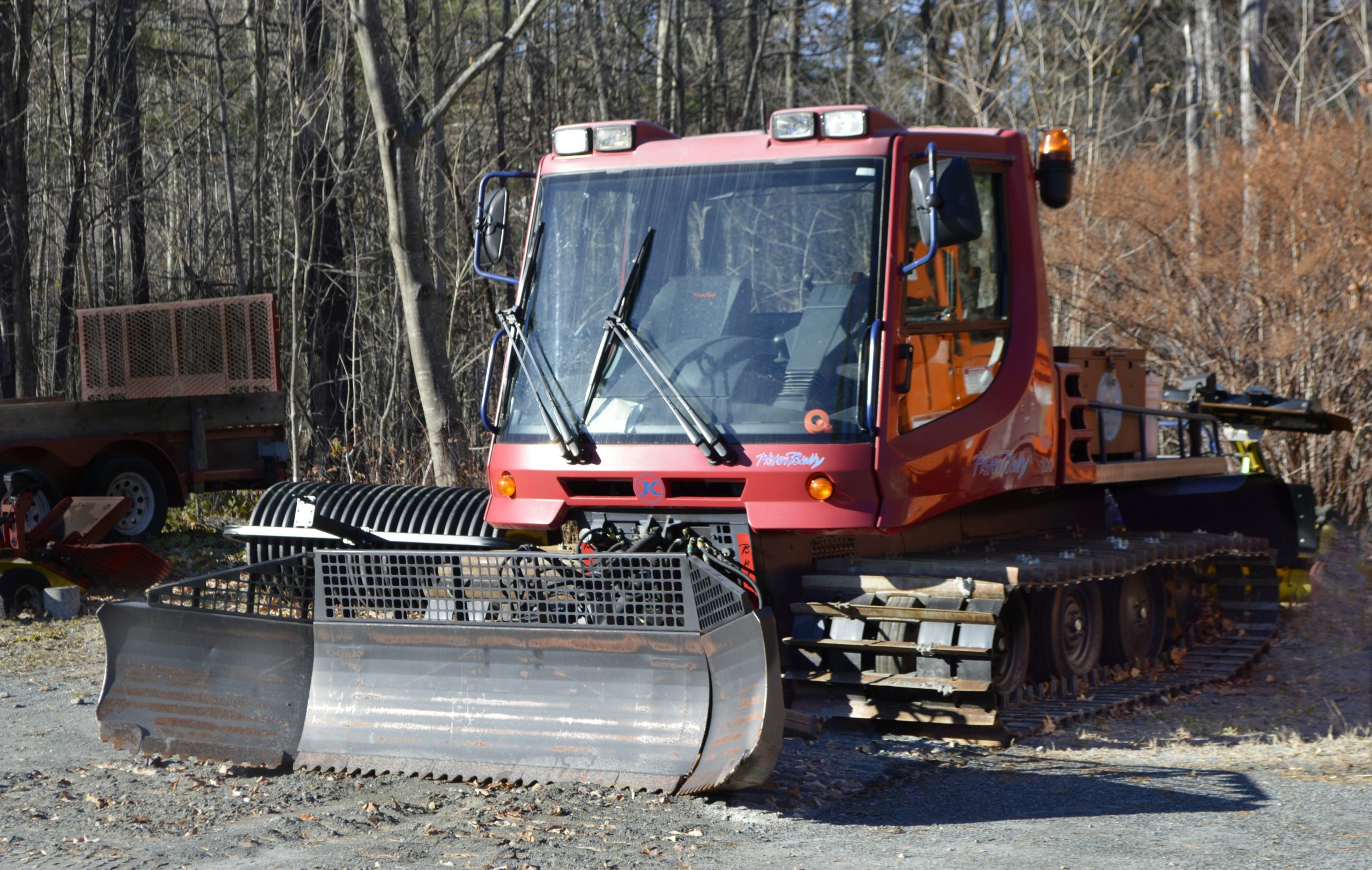
There’s No Business Like Snow Business
There’s No Business Like Snow Business
By John Larrabee / Photos by Richard Sachs and Billy Mitchell
“Snowflakes are one of nature’s most fragile things, but just look what they can do when they stick together.” –Vesta M. Kelly
 Gardens have long ago been put to bed, fragile foundation plantings protected against snow sliding from the roof, and “snow birds” gone to warmer climes. Those who stay through Eastman winters prepare for snow, ice, freezing rain, hail, sleet, and bone-chilling cold. Some with dread, others with glee. When the weatherman predicts eight inches of snow for tomorrow, the night shift nurse feels a little differently about it than the downhill or cross-country skier. Therein lies the rub. Imagine what goes on in the heads and hearts of the 18 men and women who either clear the roads or groom the 36 kilometers of cross-country ski trails. People have a love/hate relationship with snow: picture the front door with skis and poles on one side and snow shovels on the other.
Gardens have long ago been put to bed, fragile foundation plantings protected against snow sliding from the roof, and “snow birds” gone to warmer climes. Those who stay through Eastman winters prepare for snow, ice, freezing rain, hail, sleet, and bone-chilling cold. Some with dread, others with glee. When the weatherman predicts eight inches of snow for tomorrow, the night shift nurse feels a little differently about it than the downhill or cross-country skier. Therein lies the rub. Imagine what goes on in the heads and hearts of the 18 men and women who either clear the roads or groom the 36 kilometers of cross-country ski trails. People have a love/hate relationship with snow: picture the front door with skis and poles on one side and snow shovels on the other.
The transition from fall to winter in Eastman is a complicated dance. The first week in November finds some of the crew putting the warm-weather amenities to bed and others preparing the trails for ski season. Dead and downed trees are cleared, limbs are chipped, and stumps are removed. “Trails that receive our volume of year-round use need an overhaul every three to five years,” says Mike Gornnert, Eastman’s Chief Maintenance Officer. “We’ll mow the grass and mulch and remove the leaves on the trails to prevent that material from interfering with the first snow bonding with the ground.”
Snow Day!
It’s 4:30 a.m. on a snowy morning in January. While some of us are still asleep, snuggled in our warm beds, men and women of Eastman’s maintenance team are already mustered around a table in the break room, listening to a variety of television, radio, and Internet weather reports. A video camera outside the maintenance building gives Mike real-time weather conditions that he can monitor from his home several towns away. He watches conditions on I-89 in real time as well to help grasp the severity of weather conditions; he includes school closings and event cancelations in his decision-making. He also subscribes to a forecasting service out of Rhode Island that helps him plan the division of labor and is an invaluable resource when budgeting for sand and salt and any contractors needed for plowing and sanding. Armed with all this information, Mike, the road crew, and ski trail grooming teams develop a game plan.
The Road Crew
The looping, roller coaster roads that developer Emil Hanslin laid out in 1968 for the Eastman Community Association were intended to fit into the plan to “develop the land so that the impact upon the natural environment is minimized and the beauty of the surrounding landscape is conserved and enhanced.” The road design also has a traffic-calming effect that helps with safety. As explained by a landscape architect, the curving, up-and-down of the roads enhance the privacy and seclusion of homes and driveways. Consequently, not many residents have to deal with headlights in their windows.
“Our roads are beautiful. They are also challenging to maintain. The natural ridges require more ditching and culverts; the paved roads are intentionally narrow, with soft shoulders, so a variety of equipment is used,” according to Mike. “Our road crew does have its act together. Another factor with our roads and walkways: many of our drivers in Eastman are from New York, New Jersey, Massachusetts, and Connecticut where roads are faster and winter maintenance is more intense.”
Dale Bevilacqua is superintendent of Eastman’s Roads and Facilities Maintenance. When the snow flies, he and his crew are ready. In addition to working in two shifts, the crew rotate on-call schedules, so that enough of the crew are ready to respond to whatever conditions the weather may bring.
“If ice and freezing rain start at midnight, or there’s a six-inch snowstorm on the way, everyone is on call,” states Mike, who admits to a steep learning curve when he left golf course management to become Eastman’s Chief Maintenance Officer. “Winter operations were new to me, but I managed the transition, including no vacation until the thaw.”
Paved roads at the main entrance, the north entrance at Draper Road, Road Round the Lake, and school bus routes are the first priority. Residents who work nightshifts and early shifts need to have clear and safe roads to get to work, so there is a priority list for handling winter roads and facilities.
Once again, the road and facilities crew have their act together. All assigned operators follow a detailed checklist for the plow routes. Roads and fire lanes are cleared in a certain order. Notes on the tic list detail the sanding auger and spinner settings, speed limits, and where to spread certain salts based on proximity to water bodies or the location of drainage culverts. There are reminders to note special conditions, downed trees, washouts, and other challenges. Winter maintenance is both a science and an art.
The team clears facilities at South Cove, the ECA office, and The Center at Eastman as early as possible, usually starting the day shoveling or blowing snow off walkways and away from emergency exits. “There hasn’t been a winter, and there never will, when we don’t get calls from residents concerned about not getting plowed out early enough and such,” says Mike. “It’s part of the winter experience.”
The Grooming Crew
Billy Mitchell, Golf Course and Outdoor Amenity Maintenance Superintendent, supervises a crew of three full-time staff, four seasonal staff, and a full-time mechanic whose primary goal, according to Mike, “is to get that first snow to adhere strongly to the frozen ground in a thick base.
“This is some of the science of grooming Nordic ski trails,” Mike said. “If there is too much moisture in the snowpack, early grooming can create glacier-like ice. If the first snowfall is delicate and cold, immediately packing it down might break the delicate flakes and create ball-bearings out of the crystal, or sugar snow.”
“A four-inch first snow is a good start. Roll it? Squish it? Blade it? The goal is to get a uniform consistency and depth on top of a well-bonded first snow. This can be done through various techniques, using numerous equipment and tools—all dependent on air temperature, ground temperature, humidity and other weather conditions,” Mike continues. Not many skiers may be aware of the thought and effort that goes into grooming our 36 kilometers of trails.
The PistenBully can groom 50 to 80 percent more miles per hour than a snow machine can. So when the snowpack is deep enough, consistent, and completely frozen, the PistenBully is put to work. Groomers need a four-inch base to use the PistenBully. The same two members of Billy’s team are usually at the wheel, and they know what they are doing. The machine creates a corduroy trail and a ski track. If the snowpack is not ideal, the treads of the PistenBully can flip the snow out and expose grass, rocks and dirt, which is not good. So the operators will test the conditions on the Practice Loop before tackling the flat trails.
While grooming on flat ground may be fine, the snowpack-base bond may not hold on the hilly trails, and skiers will complain that “grooming is too deep.” This is not the case; the base has flipped over. Changes in conditions on the trails cannot always be anticipated. For example, trails shaded by trees and trails in the sun need different approaches. Groomers try to allow for the maximum amount of time between setting the track and skier traffic. With changing weather, the most economical time is early morning.
Each member of the grooming staff—whether novice or veteran—admits that there is always something to learn. Some weather conditions come around every few years and with them new learning opportunities. As Mike says, “Just like doctors, our team of groomers strives to do no harm.”
The Skating Rink
For the past two years, Billy’s crew has constructed and maintained a large, portable skating rink at the overflow parking area on Greensward Drive to replace the skating pond behind The Center that was nearly impossible to maintain and closed as often as it was open. Roughly 80-foot square, the unit goes together in four-foot sections somewhat like Legos and provides a level, clean skating surface. The Grantham Fire Department fills the rink with water from the lake—an activity that also provides training for the department members. The grooming crew keeps the ice clear and grooms it using a hose and a small handheld device called a Bambini. Shifting weather conditions can keep the ice groomers busy. The rink, with lights for night skating, is very popular, and some skaters bring goals to the ice for pickup hockey games.
Dale Bevilacqua and Billy Mitchell share a tiny office, personnel and equipment. This requires regular communication, which Billy says “has never been better.”
Often behind the scenes, Eastman’s vigilant and hard-working road and grooming crews keep the roads and walkways clear and safe and the skiing and skating accessible and pleasurable. These folks have learned that rather than wrestle with what the weather brings them, it is better to engage in a choreographed dance of give and take, bob and weave, making the best out of what the heavens deliver.
John Larrabee is a retired educator and administrator. Born in New Hampshire, he moved around the country before finally roosting in the Granite State. He is chair of the Lakes & Streams Committee, supervises the Youth Conservation Corps, and volunteers for Kearsarge/Sunapee Habitat for Humanity and for The Fells.
Request More Information from:
Receive your complimentary Relocation guide and magazine

